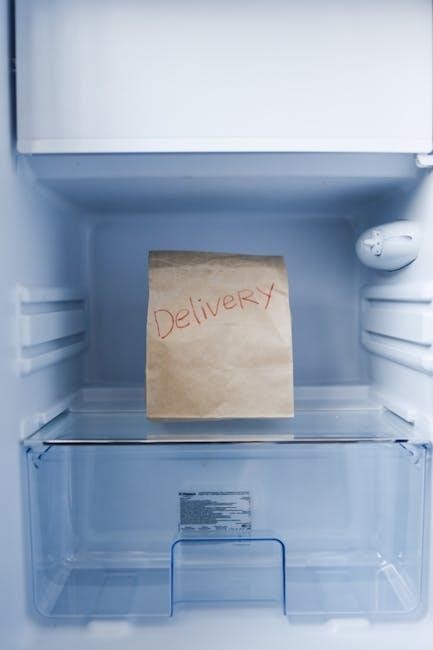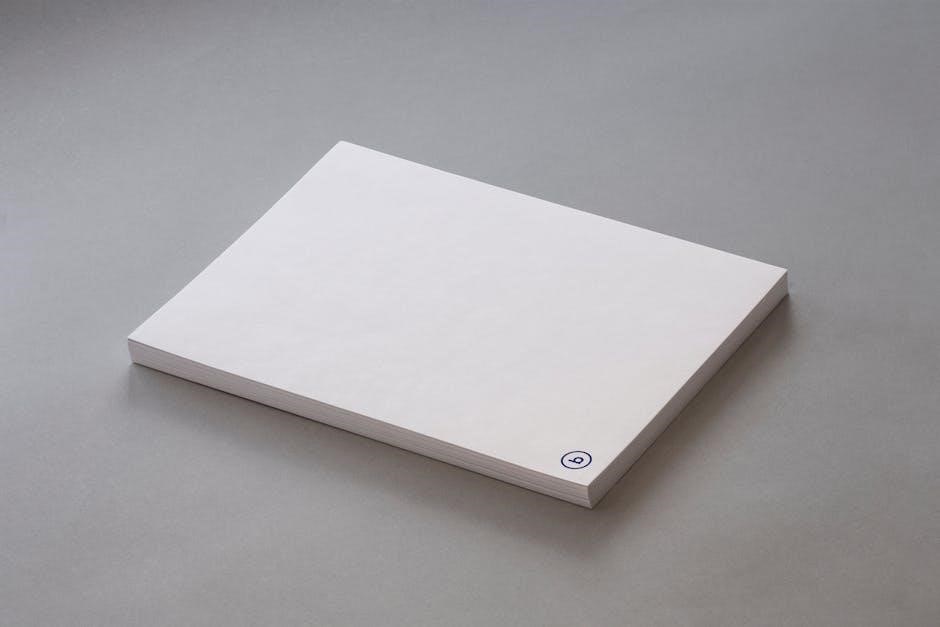A fridge temperature record sheet is a document used to monitor and log refrigerator temperatures‚ ensuring food safety‚ compliance‚ and optimal storage conditions. It helps maintain accurate records‚ supporting regulatory requirements and consistency in temperature monitoring‚ while preventing spoilage and ensuring the quality of stored items.
What is a Fridge Temperature Record Sheet?
A fridge temperature record sheet is a document used to track and monitor refrigerator temperatures regularly. It ensures food safety‚ prevents spoilage‚ and maintains compliance with health regulations. Available in formats like PDF‚ Excel‚ or Word‚ these sheets allow users to log daily temperature readings‚ note any deviations‚ and take corrective actions. They are essential for businesses‚ medical facilities‚ and homes to ensure optimal storage conditions and maintain the quality of perishable items.
Why is Temperature Monitoring Important?
Temperature monitoring is crucial for maintaining food safety and quality. It prevents spoilage and bacterial growth by ensuring fridge temperatures stay within safe ranges. Regular checks help comply with health regulations and prevent contamination risks. Consistent monitoring also ensures the longevity and freshness of stored items‚ whether for food storage or medical supplies. Accurate records support traceability and accountability‚ making it an essential and vital practice for homes‚ businesses‚ and healthcare facilities alike‚ ensuring safety and quality always.
Importance of Maintaining Fridge Temperatures
Maintaining consistent fridge temperatures is vital for food safety‚ preventing bacterial growth‚ and ensuring compliance with health regulations. It helps preserve food quality and prevents spoilage‚ safeguarding health and reducing waste.
Food Safety and Spoilage Prevention
Maintaining proper fridge temperatures is crucial for preventing bacterial growth and foodborne illnesses. Consistent cooling inhibits spoilage‚ ensuring food remains fresh and safe for consumption. Temperature fluctuations can lead to contamination‚ making regular monitoring essential. By using a temperature record sheet‚ you can track conditions‚ identify potential risks‚ and take corrective actions promptly. This proactive approach safeguards food quality‚ reduces waste‚ and ensures compliance with health standards‚ protecting both consumers and businesses from potential harm.
Compliance with Health Regulations
Using a fridge temperature record sheet ensures compliance with health regulations by providing documented proof of consistent temperature control. Health agencies require precise monitoring to prevent foodborne illnesses and contamination. Regular logging demonstrates adherence to safety standards‚ making audits and inspections smoother. Non-compliance can lead to penalties or legal issues‚ while accurate records protect businesses from liability. By maintaining detailed logs‚ organizations show accountability and due diligence‚ ensuring they meet all regulatory requirements effectively.
Optimal Storage Conditions
Maintaining optimal storage conditions is crucial for preserving food quality and safety. A fridge temperature record sheet helps ensure temperatures remain within the ideal range of 2°C to 5°C‚ preventing spoilage and contamination. Consistent monitoring guarantees that perishable items stay fresh longer‚ reducing waste and maintaining nutritional value. By tracking temperature fluctuations‚ you can address issues promptly‚ ensuring a stable environment for stored goods. This systematic approach supports food safety and extends the shelf life of refrigerated products effectively.

Types of Temperature Log Sheets
Temperature log sheets vary by purpose‚ including commercial fridge logs for food safety‚ medical refrigerator logs for sensitive supplies‚ and home fridge logs for personal use. Each type ensures accurate monitoring and compliance with specific storage requirements‚ helping maintain quality and safety standards effectively.
Commercial Fridge Temperature Logs
Commercial fridge temperature logs are essential for food safety in restaurants‚ cafes‚ and food businesses. They ensure compliance with health regulations by monitoring storage conditions‚ preventing spoilage‚ and maintaining consistent temperatures. These logs typically include date‚ time‚ temperature readings‚ and corrective actions‚ helping businesses meet food safety standards and avoid potential violations. Regular use of these logs supports traceability and accountability during inspections or audits‚ ensuring a safe environment for food storage and consumption.
Medical Refrigerator Temperature Logs
Medical refrigerator temperature logs are critical for healthcare facilities to monitor storage conditions for vaccines‚ medications‚ and biological samples. These logs ensure compliance with strict medical standards‚ preventing temperature fluctuations that could compromise sensitive materials. They typically include detailed records of temperature readings‚ corrective actions‚ and verification by staff. Regular monitoring and accurate documentation are essential to maintain the integrity of medical supplies and ensure patient safety‚ making these logs indispensable in healthcare settings.
Home Fridge Temperature Logs
Home fridge temperature logs are essential for maintaining food safety and preventing spoilage. They help track storage conditions‚ ensuring your refrigerator operates within the ideal temperature range of 2-5°C. Regular monitoring prevents bacterial growth and keeps perishables fresh. These logs are simple to use‚ allowing you to record daily readings and note any adjustments. Customizable templates are available for download as PDFs‚ making it easy to maintain accurate records and ensure your fridge functions efficiently for optimal food preservation.
Optimal Fridge and Freezer Temperatures
The ideal temperature for a fridge is between 2°C and 5°C‚ while freezers should operate at -15°C to -18°C. These ranges ensure food safety and proper storage.
Ideal Temperature Ranges for Fridges
The ideal temperature range for a fridge is between 2°C and 5°C. This range ensures food stays fresh‚ prevents bacterial growth‚ and maintains quality. Consistently monitoring and recording these temperatures in a fridge temperature record sheet helps verify compliance with food safety standards. Deviations from this range can lead to spoilage or contamination‚ making regular checks essential for optimal storage conditions and long-term food preservation.
Ideal Temperature Ranges for Freezers
The ideal temperature range for freezers is between -15°C and -18°C. This range ensures proper freezing‚ prevents bacterial growth‚ and maintains food quality. Consistently recording these temperatures in a freezer temperature log is crucial for food safety and compliance. Temperatures below -18°C can cause freezer burn or ice crystal formation‚ while higher temperatures may lead to spoilage. Regular monitoring ensures optimal storage conditions and prevents potential food safety issues.

Creating a Fridge Temperature Record Sheet
A fridge temperature record sheet should include date‚ time‚ temperature readings‚ and actions taken. Customize templates to suit your needs‚ ensuring accurate and organized monitoring of fridge conditions.
Essential Elements of a Temperature Log
A temperature log must include the date and time of each reading‚ temperature values‚ and a section for corrective actions. It should also specify the location of the fridge and the person recording the data. Including optimal temperature ranges ensures quick identification of deviations. Additional notes or comments sections allow for documenting unusual observations or maintenance activities‚ ensuring comprehensive and clear records for compliance and review.
How to Design a Custom Temperature Record Sheet
Start by including a header with the fridge location and responsible person. Create a table with columns for date‚ time‚ temperature‚ and actions. Add a section for optimal temperature ranges and a notes area for comments. Use a clean layout with clear fonts and ensure the design is easy to fill out manually or digitally. Include verification steps to confirm accuracy and compliance‚ making it adaptable for various settings like home‚ commercial‚ or medical use.

Using a Fridge Temperature Record Sheet
Regularly monitor and record temperatures to ensure consistency and compliance. Take readings at specific intervals‚ interpret data for trends‚ and take corrective actions if temperatures deviate from safe ranges.
When to Take Temperature Readings
Temperature readings should be taken at least once daily‚ with additional checks during peak usage or after power outages. This ensures consistent monitoring and early detection of issues; Maintaining accurate records helps verify compliance and food safety. Optimal fridge temperatures are between 2-5°C‚ while freezers should be -15°C or lower. Regular checks prevent spoilage and ensure stored items remain safe and viable.
How to Interpret Temperature Data
Interpreting temperature data involves checking recorded readings against optimal ranges (2-5°C for fridges‚ -15°C or lower for freezers). Identify trends or fluctuations that may indicate issues. If temperatures exceed safe levels‚ take corrective actions like adjusting settings or contacting maintenance. Consistent monitoring ensures compliance with food safety standards and prevents spoilage. Regular reviews of the data help maintain storage conditions and protect stored items from degradation.
Actions to Take if Temperatures are Out of Range
If temperatures deviate from the ideal range‚ immediate action is required. Adjust the appliance settings‚ inspect for malfunctions‚ and document the issue. Ensure corrective actions are recorded‚ including the date‚ time‚ and steps taken. If unresolved‚ contact maintenance or replace the unit. Regularly review logs to prevent recurring issues and maintain compliance with food safety standards. Timely interventions safeguard stored items and uphold regulatory requirements. Consistent follow-up ensures optimal conditions are restored and maintained.
Benefits of Digital Temperature Record-Keeping
Digital tools automate temperature monitoring‚ provide real-time alerts‚ and store data securely. They enhance accuracy‚ reduce errors‚ and ensure compliance with food safety regulations efficiently.
Advantages of Using Apps and Software
Apps and software offer real-time monitoring‚ automated alerts for temperature deviations‚ and secure data storage. They reduce manual errors‚ improve compliance‚ and provide customizable templates. Accessing records via the cloud enhances traceability and accountability during audits. These tools are essential for maintaining precise temperature control and ensuring food safety standards are met consistently.
How to Automate Temperature Monitoring
Automating temperature monitoring involves using digital thermometers and sensors connected to software or apps. These devices collect real-time data‚ store it securely‚ and send alerts for deviations. Smart systems integrate with existing record-keeping tools‚ reducing manual effort and ensuring accuracy. Automation streamlines compliance‚ improves efficiency‚ and minimizes human error‚ making it easier to maintain consistent and reliable temperature records for food safety and regulatory standards.

Downloading and Customizing Templates
Download free fridge temperature record sheet PDF templates online‚ customize them to suit your needs‚ and print them. Adjust fonts‚ colors‚ or add notes for better organization and compliance.
Where to Find Free PDF Templates
Free fridge temperature record sheet PDF templates are available online from reliable sources like food safety websites‚ template repositories‚ and official health portals. Websites such as food.gov.uk offer downloadable forms designed for food safety compliance. These templates are often customizable‚ allowing users to adapt them to specific needs. They can be downloaded in PDF‚ Word‚ or Excel formats‚ making it easy to print or edit digitally. Using these templates ensures consistency and organization in temperature monitoring and record-keeping.
How to Customize Templates for Your Needs

Customizing fridge temperature record sheet PDF templates is straightforward. Use software like Adobe Acrobat or Excel to modify fields‚ add logos‚ or adjust layouts. Tailor columns to include specific data points‚ such as date‚ time‚ temperature readings‚ and corrective actions. Add notes or instructions to suit your workflow. This ensures the template aligns with your organization’s requirements‚ making it more effective for monitoring and compliance. Customization helps streamline record-keeping and improves accuracy in temperature tracking.
Freezer Temperature Log Sheets
Freezer temperature log sheets are essential for monitoring and recording freezer conditions. They ensure compliance with safety standards‚ track temperature fluctuations‚ and maintain accurate records for audits and quality control;
Specific Requirements for Freezer Monitoring
Freezer monitoring requires precise temperature tracking‚ typically between -15°C and -18°C‚ to ensure food and medical supplies remain safe and viable. Regular checks‚ often daily‚ are essential to maintain consistency. Detailed records must include date‚ time‚ temperature readings‚ and any corrective actions taken if deviations occur. Compliance with health and safety standards is critical‚ as improper storage can lead to spoilage or contamination. Accurate documentation supports audits and ensures operational efficiency.

How to Maintain Freezer Temperature Records
Maintaining freezer temperature records involves regular checks‚ typically daily‚ to ensure temperatures remain within safe ranges (-15°C to -18°C). Use digital tools or log sheets to document readings‚ noting any deviations. Store records securely‚ either physically or digitally‚ for traceability. Automated sensors can streamline data collection‚ while cloud storage ensures accessibility. Regular audits and reviews of these records help verify compliance and maintain operational efficiency‚ supporting food safety and regulatory standards.

Food Safety Regulations and Temperature Logs
Temperature logs are crucial for ensuring compliance with food safety regulations‚ providing traceability and accountability during audits. They help maintain accurate records‚ supporting regulatory requirements and consistency in monitoring.
Relevant Food Safety Standards
Food safety standards‚ such as HACCP and FDA regulations‚ require precise temperature monitoring to prevent spoilage and contamination. Temperature logs ensure compliance by maintaining records of fridge and freezer temperatures‚ typically below 5°C for refrigeration and -18°C for freezing. These standards emphasize the importance of regular checks and corrective actions if temperatures deviate‚ ensuring consumer safety and regulatory adherence. Proper documentation supports traceability during audits and inspections.
How Temperature Logs Support Compliance
Temperature logs provide essential documentation for audits and inspections‚ ensuring adherence to food safety regulations. By maintaining accurate records of fridge and freezer temperatures‚ businesses demonstrate compliance with standards like HACCP and FDA guidelines. These logs offer traceability‚ accountability‚ and proof of consistent monitoring‚ helping to mitigate risks and ensure consumer safety. Regular temperature checks and corrective actions‚ when documented‚ reinforce regulatory requirements and support a culture of compliance in food handling and storage environments.
Daily Temperature Log Example
A daily temperature log typically includes columns for date‚ time‚ temperature readings‚ and actions taken. It provides a clear‚ organized way to track fridge and freezer conditions‚ ensuring consistency and compliance with safety standards. Below is a sample format:
| Date | Time | Temperature (°C) | Actions |
|---|---|---|---|
| MM/DD/YYYY | HH:MM | ##.## | Notes/Adjustments |
This format is easy to use and essential for maintaining accurate records.
Sample Fridge Temperature Record Sheet
A sample fridge temperature record sheet includes columns for date‚ time‚ temperature readings‚ and corrective actions. It typically looks like this:
| Date | Time | Temperature (°C) | Actions |
|---|---|---|---|
| 10/27/2025 | 08:00 | 4.0 | Within range |
| 10/27/2025 | 12:00 | 4.5 | Within range |
| 10/27/2025 | 16:00 | 3.8 | Within range |
| 10/27/2025 | 20:00 | 4.2 | Within range |

This format ensures consistent monitoring and compliance with food safety standards‚ maintaining temperatures between 2°C and 5°C for optimal storage conditions.
Corrective Actions for Temperature Deviations
If temperatures deviate from the ideal range‚ check the thermometer‚ adjust settings‚ and ensure proper door seals. Document actions taken to restore optimal conditions and maintain compliance.
What to Do if Temperatures are Too High or Low
If temperatures deviate from the ideal range‚ immediately check the thermometer for accuracy. Adjust the refrigerator settings to restore optimal conditions. Ensure all doors and seals are functioning properly to maintain consistent temperatures. Document the corrective actions taken‚ including the date‚ time‚ and any adjustments made. Review historical temperature records to identify recurring issues and prevent future deviations. Prompt action ensures food safety‚ prevents spoilage‚ and maintains compliance with health regulations.
Difference Between Fridge and Freezer Logs
Fridge logs track cooling temperatures (2-5°C)‚ while freezer logs monitor freezing conditions (below -15°C). Each serves distinct purposes‚ ensuring proper storage for their respective items.
Unique Aspects of Each Log Type
Fridge logs focus on maintaining temperatures between 2-5°C for food safety and freshness‚ while freezer logs ensure temperatures below -15°C for long-term preservation. Fridge logs often include defrost schedules and storage organization notes‚ whereas freezer logs emphasize preventing ice crystal formation and maintaining humidity levels. Both logs are essential for compliance‚ but their specific requirements differ based on the storage needs of perishable items and medical supplies‚ ensuring optimal conditions for their intended purposes.
Common Mistakes to Avoid
Common errors include inconsistent logging‚ failure to act on temperature deviations‚ and improper record-keeping. Ensure accurate‚ regular entries and address issues promptly to maintain compliance and safety.
Errors in Temperature Monitoring and Recording
Common errors include inconsistent temperature logging‚ failure to address deviations‚ and improper use of thermometers. Infrequent checks and delayed corrective actions can compromise food safety. Additionally‚ poor record organization and legibility hinder traceability. Ensuring accurate‚ timely‚ and well-documented logs is crucial for compliance and maintaining optimal storage conditions. Neglecting these practices can lead to regulatory issues and spoilage‚ emphasizing the importance of precise and regular monitoring to uphold safety standards and operational efficiency.
Best Practices for Long-Term Record-Keeping
Store temperature records digitally or in secure‚ organized files. Regularly review logs for accuracy and compliance. Ensure accessibility for audits and maintain records for the required duration.
How to Store and Review Temperature Records
Store temperature records digitally in secure‚ organized files or physically in designated binders. Regularly review logs to ensure accuracy and compliance with health regulations. Check for consistency‚ completeness‚ and adherence to optimal temperature ranges. Archive records for the recommended retention period‚ ensuring easy accessibility for audits or inspections. Maintain backup copies to prevent data loss. Schedule periodic reviews to identify trends or potential issues‚ ensuring long-term food safety and operational efficiency.
Training Staff on Temperature Monitoring
Train staff to understand proper temperature monitoring procedures‚ ensuring accurate and consistent record-keeping. Emphasize the importance of regular checks and maintaining compliance with food safety standards.

Ensuring Consistent and Accurate Record-Keeping
Consistent and accurate record-keeping is vital for maintaining reliable temperature data. Use standardized templates and train staff to follow precise logging procedures. Regularly review records for errors or inconsistencies. Implement digital tools to automate data entry and reduce human error. Ensure all logs are dated‚ signed‚ and stored securely for future reference. Accurate records not only support compliance but also help identify trends and potential issues in temperature control‚ ensuring food safety and operational efficiency.
Using a fridge temperature record sheet ensures food safety‚ compliance‚ and efficient storage. Regular monitoring and accurate records help maintain optimal temperatures‚ preventing spoilage and potential health risks.
Final Thoughts on the Importance of Temperature Records
Maintaining accurate temperature records is crucial for ensuring food safety‚ preventing spoilage‚ and complying with health regulations. These records provide traceability and accountability‚ essential for audits and inspections. By using tools like fridge temperature record sheets‚ businesses and households can monitor storage conditions effectively. Regular checks and documentation help maintain optimal temperatures‚ reducing risks and ensuring the quality of stored items. Digital solutions further simplify this process‚ making long-term record-keeping efficient and reliable.